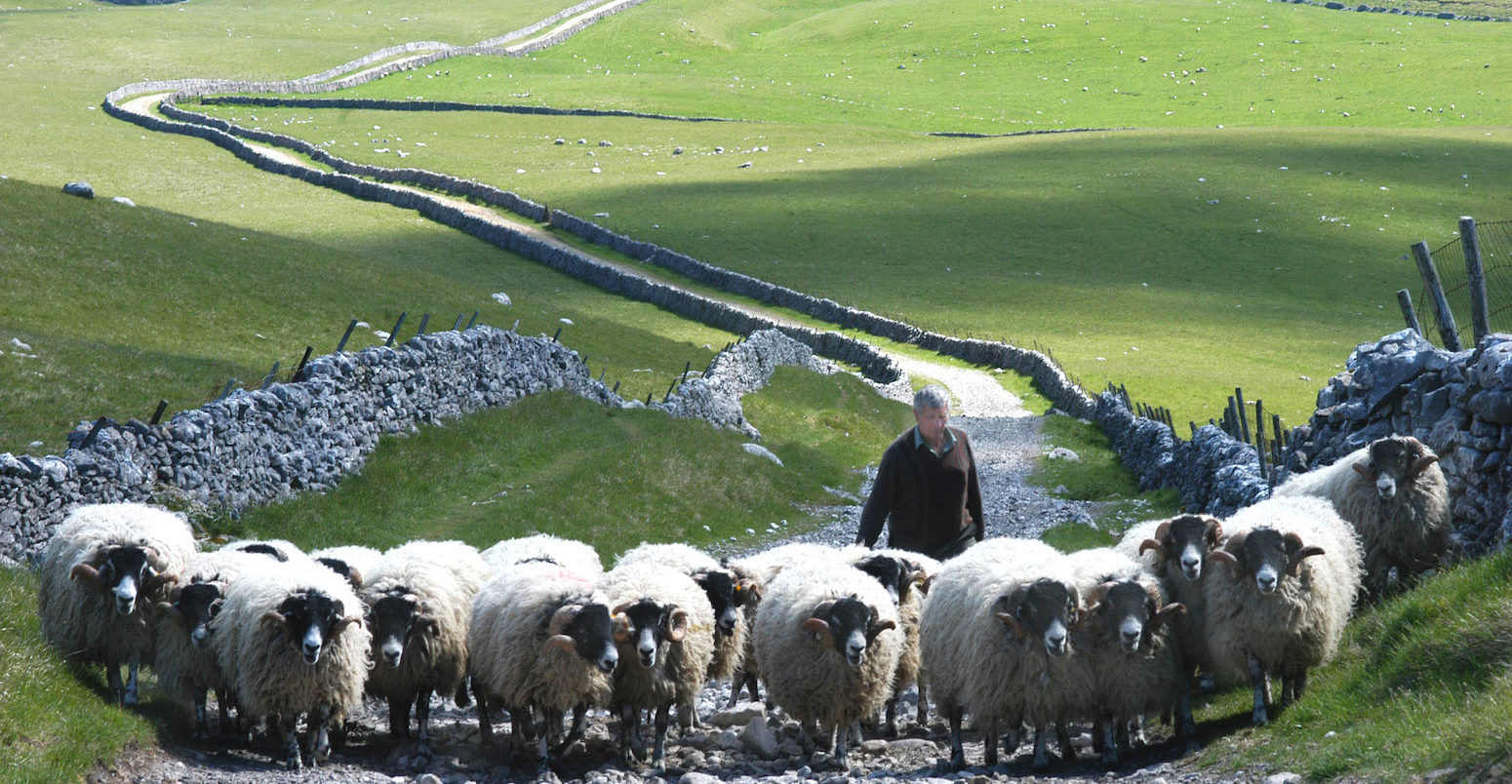
Q&A: Will the UK’s new farm payments cut emissions and help nature?
Multiple Authors
02.01.23Multiple Authors
01.02.2023 | 5:03pmThe UK government hasreleased detailsof its new funding schemes for farms in England, which are intended to boost the nation’s biodiversity and help to tackle climate change.
The new system of “environmental land management schemes” (Elms) has beendescribedby the government as the “biggest change in agricultural policy in half a century”.
Under the programme, farmers and landowners can apply for public money to support up to 270 activities that benefit the environment, from restoring hedgerows to avoiding insecticides. There will also be funds available to support more ambitious rewilding projects.
The schemes are a “replacement” for themuch-criticisedEU common agricultural policy. But they, too, have proved controversial, especially as the details have taken so long to emerge while EU-style payments are gradually redrawn.
Scotland, Wales and Northern Ireland are developing their own replacements for EU farming subsidies, but these policies have not yet been put into law.
In this article, Carbon Brief assesses the state of Elms and other post-Brexit farming policies in the UK, plus the impact they are expected to have on the nation’s environmental goals. This includes an interactive table of the measures that have been announced so far for farmers in England.
- What are environmental land management schemes (Elms)?
- How has the UK been paying farmer subsidies since leaving the EU?
- What are the new policies being rolled out in England?
- How are the policies expected to be different in the devolved nations?
- How will farmers be affected by Elms?
- Will Elms help the UK to meet its climate and biodiversity targets?
What are environmental land management schemes (Elms)?
The “environmental land management schemes” (Elms) is England’s successor for EU policy on farm payments.
Since the Brexit referendum, UK policymakers have been working on replacements for a variety of European Union laws.
The common agricultural policy (CAP) is the EU’s main farming legislation. It sets out how much money farmers receive for maintaining their land and the actions they must do to receive these funds.
Aroundone-thirdof the EU’s overall annual budget is put towards the CAP.
(For more on the EU’s common agricultural policy, see Carbon Brief’sQ&Aon whether CAP reforms will help to tackle climate change.)
Leaving the EU gives the UK the opportunity to change these often-criticisedrules around agricultural payments.
Under the CAP, farmers receive direct income support based on the size of their farmland. There are extra payments available foryoung farmersand using farming practices thatbenefitthe environment.
Post-Brexit, farmers in Scotland, Wales and Northern Ireland are continuing to receive full direct payments at the same level as they did under the CAP. But rates for farmers inEnglandare being reduced on a gradual basis between 2021 and 2027.
Sustainable food production and protecting and enhancing nature go hand in hand.
— Defra UK (@DefraGovUK)January 5, 2023
That’s why we’re increasing payments for farmers delivering this through our future farming schemes.
: BBC
Read more:https://t.co/dfyAo27zNUpic.twitter.com/KBGcMGlM0Y
A big focus for the UK government has been the gradual removal of these direct payments. Farmers will instead be paid to participate in schemes that benefit nature and the environment.
Agriculture is a devolved issue in the UK. England’s post-Brexit agricultural policies largely fall under Elms, the latest details of which were announcedlast week.
Policies in Scotland, Wales and Northern Ireland are still a work in progress.
Moving away from the CAP and other EU “red tape” formed part of the Brexitdebate, saysDr Ludivine Petetin, a legal expert on agri-environmental issues atCardiff Universityand the co-author ofBrexit and Agriculture.
Petetin says the 2016 Brexit vote was partly seen as a time to “start something new” in agriculture and support farmers to do “something good” for the environment. But, she tells Carbon Brief:
“When you are starting to look into the details and how to implement, it’s often easier to go back to what you know rather than implementing something completely new.
“A lot of what is being proposed or exists currently is more of the same…We thought that this is going to be a great opportunity for the four nations to think outside the box and do something different. And, in the end, it’s more of the same.”
The option to leave EU agricultural policies behind has been a potential “silver lining” of Brexit. But, as Carbon Brief details below, the extent to which the UK is diverging from these policies differs between nations.
How has the UK been paying farmer subsidies since leaving the EU?
Under the common agricultural policy, UK farmers received income support to manage land.
Farmers in Scotland, Northern Ireland and Wales still receive these full payments – with funding now coming from the UK government, rather than from the EU.
Payments in England have beenreducingon a phased basis since 2021 and the government has been clear that they will begonecompletely by 2028.
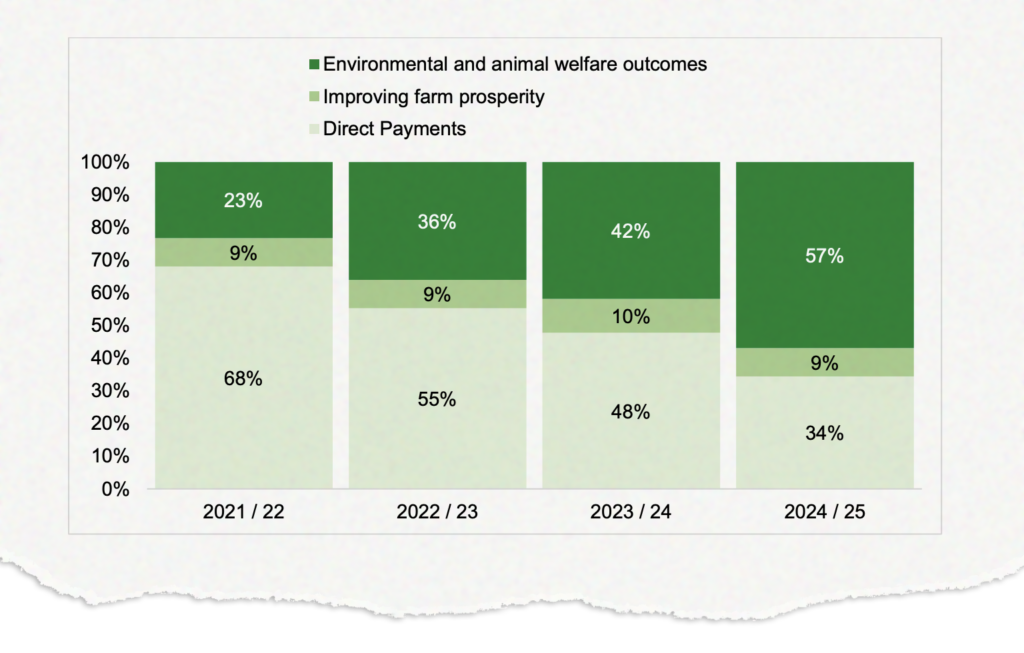
The UK government decided to phase out basic payments in favour of action-based schemes after Brexit. The 2020Agricultural Transition Plan, which set out when and how farming will change this decade, stated that the government’s aim was for all English farmers to be “running sustainable businesses that do not need to rely on public subsidy” by 2028.
TheDepartment for Environment, Food and Rural Affairs(Defra) hasdescribedthe CAP as “flawed”, adding that payments such as land-based funding “can undermine incentives for widespread productivity improvement and are bad value for taxpayers”.
Without direct payments, almost four in 10 English farmers would have suffered financial losses in recent years, according toDefra.
Instead of direct payments, England will fund initiatives aimed to help nature and biodiversity. Plans on how and when these funds will be geared towards other initiatives in future differ across UK nations.
What are the new policies being rolled out in England?
Elms consists of three distinct components: theSustainable Farming Incentive(SFI);Countryside Stewardship(CS); andLandscape Recoveryschemes.
The first two involve paying farmers and landowners for undertaking voluntary environmental actions on their land, such as cutting back on pesticides, creating new habitats and culling non-native species.
The third has beendescribedby the government as a “more radical” approach that will support a smaller number of large-scale efforts to rewild areas of the country.
Specifics of Elms have emerged slowly in the six years since the Brexit referendum, but in January 2023 the government finally released adetailed breakdownof the policy. This included information on 270 activities that farmers can undertake in order to earn payments, primarily through SFI and CS.
Carbon Brief has created an interactive table of these measures, including 39 that are still at the planning stage.
It reveals that the most common land types for environmental improvements are grassland and arable cropland, with 49 and 50 measures, respectively. The schemes also contain funding for a handful of activities to boost the preservation of heritage sites, public engagement and animal health.
Public funding – which will be £2.4bn a year during this parliament – will be spread across SFI, CS and Landscape Recovery. The government initiallysaidit expected the fund to be “evenly split”, but it has sinceclarifiedthat funding will depend on demand for each scheme. This has promptedspeculationfrom environmental groups that less ambitious actions could be favoured.
The government alsosays有will be a role for private investment and that more details will come in theGreen Finance Strategylater in 2023.
The Elms rollout has been gradual, with some of the new payments piloted as subsidies are wound down.
这些计划受到广泛scrutiny, revision anddelays.Towards the end of 2022,rumoursbegan to swirl that the Liz Truss-led government was considering scrapping Elms in favour of a return to a land-based subsidy system.
最后,诗人Sunak政府坚持the original plan of rewarding farmers for practices with environmental benefits – albeit with modifications on previous plans.
Sustainable Farming Incentive
The SFI pays farmers to take up “sustainable farming practices” – while also maintaining food production.
This includes creating andlooking after hedgerows, avoiding insecticides, growing wildflowers to attract pollinators and planting nitrogen-fixing legumes to improve soil fertility. Farmers will generally be paid a fixed rate per hectare of land covered by such practices.
The SFI is expected to be the most broadlyaccessibleof the Elm schemes. The National Farmers Union (NFU) has beensupportiveof it, partly on the basis that it does not require the full conversion of farmland into nature sites.
The government has previouslystatedthat it plans to have at least 70% of farmers, covering 70% of farmland, taking up these agreements by 2028.
There was a limited launch of three SFI standards, mainly focusing on soil health, in 2022. The government has now announced an additional six standards in 2023 – three more than originally planned and one year earlier than the original 2024 launch date.
Thiscame afterreportsof a slow rollout by the government and low uptake from farmers during the initial phase of the scheme. Farmers had alsovoiced concernsabout a lack of information and said that SFI payments were too low to bother with.
At the start of 2023, farming minister Mark Spencerannouncedadditional SFI “management payments” of up to £1,000 per year for each farmer, amidgrowing concernsabout the shortfall in incomes as subsidies are phased out.
Several environmental groups said in a jointpress releasethat there was a risk these extra payments would not come with sufficient green strings attached, “potentially breaching the government’s commitment to public money for public goods”. They also voiced concerns that SFI’s accessibility could mean that farmers are rewarded for taking actions that provide little environmental benefit.
The Bad – whilst its good that Defra will fund nearly 280 measures. For the SFI at least they have chosen to offer complete free choice removing any packages or ambition levels. Offering individual actions won’t achieve our climate and nature targets.pic.twitter.com/sTqbJ6Ji4N
— Alice Groom (@AliceGroom2)January 26, 2023
More SFI standards will be added in the coming years, with the full set expected by 2025.
Countryside Stewardship
The CS scheme rewards farmers for undertaking work that benefits the environment on top of their farming duties. This might include creating habitats for wildlife, planting trees or improving natural flood defences.
While the SFI涵盖了“standard, universal actions”, the CS focuses on “more locally targeted actions relating to specific habitats and features”. Farmers can apply for both, as long as they are not being paid twice for the same action.
The majority of measures proposed so far – 195 out of 270 – fall under CS.
The CS was originally England’s “agri-environment” scheme while the UK was a member of the EU. During that time it was not popular, but uptake hasincreasedby 94% since 2020 as post-Brexit subsidies have been cut.
The government’stargetis to roughly double the area of land covered by CS so that 70% of farmed land is covered by the schemes in 2028. To encourage more participation, the government has alsoincreasedpayment rates by 10% and rates for one-off projects by around 50%.
For years, the government has been planning to phase CS out and replace it with a newLocal Nature Recovery(LNR) scheme, described as “the more ambitious successor to CS”. However, towards the end of 2022, it emerged that the governmentintendedto scrap LNR and instead roll over CS as the second tier of Elms.
This was confirmed in thedocumentreleased in January 2023, which pledged instead to “evolve” the current system and “reach the same ambitious destination by a smoother, faster and better route”. The justification was that the recent surge in CS uptake meant keeping the existing system would be easier for everyone.
As part of the “evolved” offering, the government revealed plans for “CS Plus”. Details are thin on the ground, but the scheme appears to support one of the original LNR goals of supporting environmental actions that are “joined up across larger areas”.
Landscape Recovery
榆树的第三个组件支持“一个较小的怒mber of longer-term, larger-scale, bespoke projects”, such as creating new woodlands and restoring areas of peatland and saltmarsh.
Most of these projects will involve bringing together groups of farmers and landowners across wider areas of the country.
The government has alreadyawarded fundingto 22 landscape recovery projects covering more than 40,000 hectares. It hadinitially plannedto support just 15, but expanded the offer after the first round of applications proved very popular.
Applications for thenext roundof “up to 25 projects” will take place in spring 2023, with a focus on “net-zero, protected sites and habitat creation”.Environmental groupswelcomed(pdf) the continued support for what they view as the most cost-effective element of Elms.
First, the good news! the highest value-for-money bit has survived: Landscape Recovery is expanding, if slowly. The first round was FAR more popular than expected, and supporting farmers on 10% of land to do LR-type activity could halve the land system’s carbon emissions by 2035.
— Dustin Benton (@dustin_benton)January 26, 2023
There werereportsin 2022 that funding for Landscape Recovery would be significantly scaled down, as well as subsequentconcernsfrom environmental groups that the government wanted to shift the weighting towards schemes that were more favourable to food production.
The scheme was originallyexpectedto receive around £800m by 2028, roughly one-third of the Elms budget, but the new figure beingcirculatedwas £50m over three years. At the time, theWildlife Trustssaidthe government had “broken its promise to reform farming”.
But the fund, called the landscape recovery scheme, has been quietly slashed to just £50m over three years, less than 1% of the budget.
— Times Politics (@timespolitics)June 11, 2022
The policy change is a significant victory for the farming lobby, which had opposed diverting money from food production
However,Marc Crouch, who facilitates theDarent Valley Farmer Cluster– a Landscape Recovery pilot project – forKent Wildlife Trust, says the concerns may be premature. He tells Carbon Brief that the smaller budget that has been announced is appropriate for the development phase of the current projects. He explains:
“There is a two-year development phase to prepare the Landscape Recovery pilots for implementation. I would expect the implementation costs to be greater than the development costs and there to be adjustments in the allocation of funding between SFI, the new CS Plus and Landscape Recovery schemes. This is also likely to depend on other factors, such as uptake and outcomes of each scheme.”
How are the policies expected to be different in the devolved nations?
Each nation in the UK is responsible for its own agricultural policy. Scotland, Wales and Northern Ireland are in different stages of developing their post-Brexit laws for farming.
Scotland
Scotland’s government released its “vision for agriculture” in March 2022. This sets out plans for the nation’s new farming policy and how Scottish agriculture will be made “sustainable and regenerative” while land management is reformed to “tackle the twin biodiversity and climate crises”.
Proposals around a new agriculture bill were opened toconsultationlast year.
Alice Groom, senior policy officer at theRoyal Society for the Protection of Birds(RSPB), says that current Scottish policy plans have a lot in common with the CAP. She tells Carbon Brief:
“Scotland is retaining quite a strong element of direct payments…They are trying to keep really quite closely aligned to the CAP.”
Yesterday, Rural Affairs Secretary@MairiGougeonupdated@ScotParlon the pathway to deliver our vision for agriculture and ensure food security in Scotland.
— Scot Gov Rural (@ScotGovRural)November 9, 2022
Watch in full▶️https://t.co/8kuVhvgkripic.twitter.com/l9KPnd91cx
Richard Lockett, a conservation and land management adviser in Scotland, says that farmers and landowners need more clarity on new policy plans.
He tells Carbon Brief that there is a general understanding among farmers that “resource management, greenhouse gas emissions and nature restoration” play key roles in the future of agriculture. He adds:
“What we don’t have any clarity on at all is what that actually translates to in detail…What does a replacement for the current AECS [agri-environment climate scheme] look like? And how is that going to be configured? What level of conditionality is going to be attached to what might be called ‘basic payments’?”
While there is “a heightened focus on nature” for farmers, “the bottom line still for most people is that it needs to make sense from a business point of view”, Lockett says. He tells Carbon Brief:
“People have different motivations and interests. Some people are just more keen on getting involved in nature restoration-type projects because they’re just more interested in them – and, perhaps, other people less so.
“When it comes to things like peatlandrestoration, then clearly the financial incentives around that are considerable and that drives a lot of interest.”
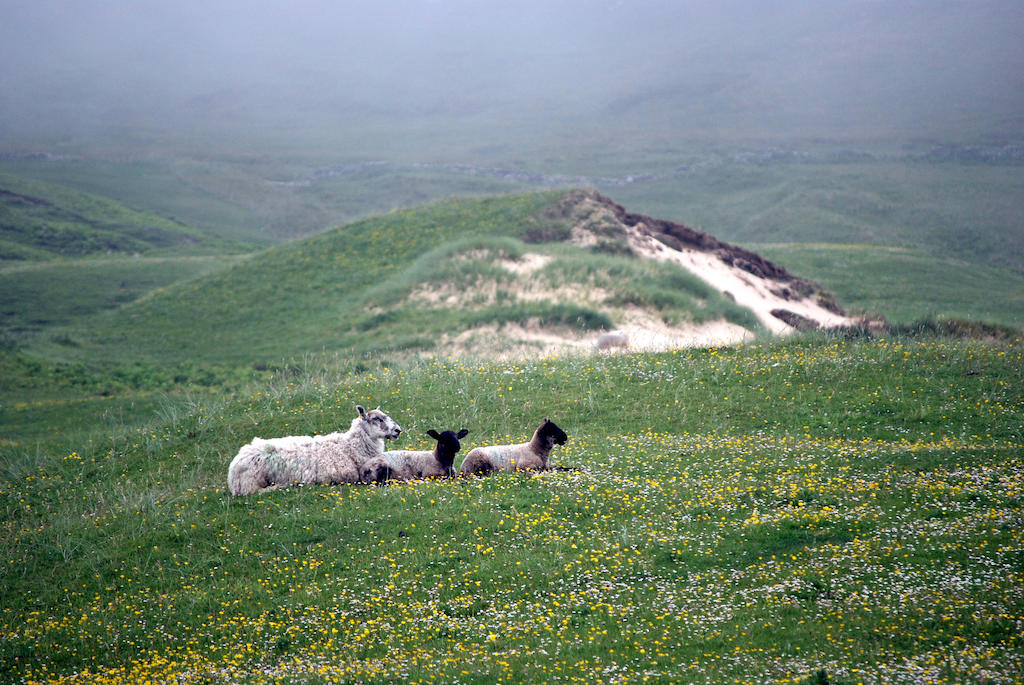
Lack of clarity on funding is one issue with post-CAP Scottish agriculture plans as they currently stand, Lockett says, adding:
“I’m interested in seeing a strong emphasis on nature-friendly farming, on climate-friendly farming, on resilient farm businesses that are going to be able to deal with the challenges that the first half of this century is going to throw at us.”
Wales
This afternoon at around 5:30pm, Rural Affairs Minister, Lesley Griffiths will deliver a statement on the introduction of the landmark Welsh Agriculture Bill.
— Welsh Government Rural Affairs (@WGRural)September 27, 2022
You can watch it onhttps://t.co/s2HlVY3gCi.
Ahead of the statement here are the Minister’s thoughts on the Bill.pic.twitter.com/t8HDcsnOF3
The Welsh government is in the midst of legislating its new farming laws,describedby the rural affairs minister as “ambitious and transformational”.
Proposalshave been put forward for the main future financial support for farmers – the “sustainable farming scheme”.
Farmers in Wales generally make a modest income andrelyon CAP payments. The sustainable farming scheme intends to replace CAP-style basic payments from 2025 onwards. It aims to support farmers to both produce food sustainably and also take nature-positive actions.
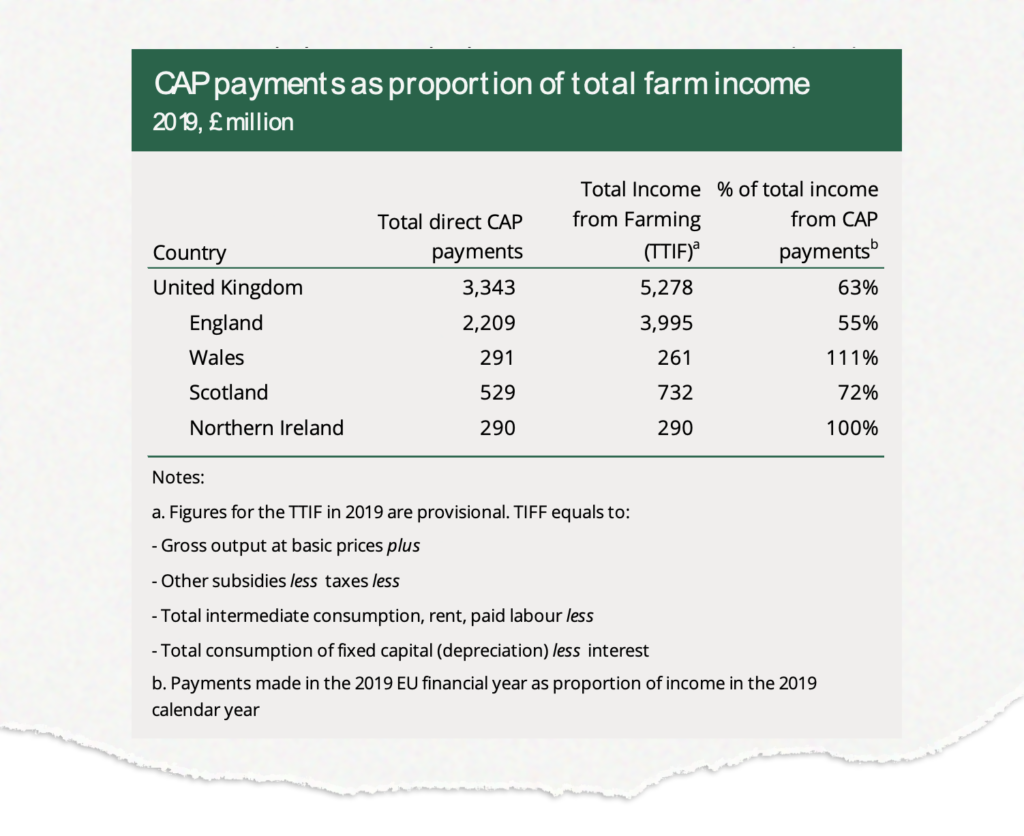
TheAgriculture (Wales) Bill2022is currently in the first stage of consideration by the Senedd. It details the plans for sustainable land management and transition payments to Welsh farmers as the government moves away from direct payments.
Groom tells Carbon Brief that Wales has “quite a cogent framework with universal, clear regulatory standards and a sustainable farming scheme”. She adds:
“One of the key aspects of that is that farmers would have to manage10% for nature, which is this magic figure that a lot of the evidence in this space points to if you’re going to recover farmland wildlife – whether that’s birds, bees or butterflies.”
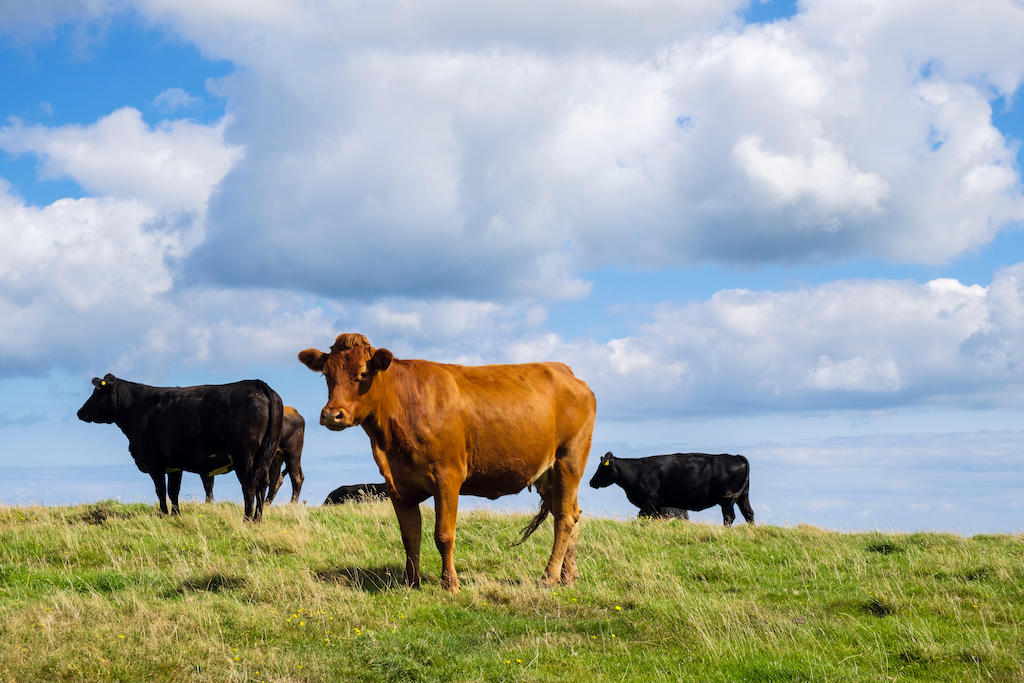
Petetin, the legal expert on agri-environmental issues from Cardiff University, says that the Welsh policy could be better tailored to support the specific landscape in the country. About 80% of agricultural land in Wales is considered a “less favourable area” for farming – either it is hilly or has other issues, such as lack of water. She says:
“The policy they are putting forward is that they’re relying on this concept of sustainable land management. Which, don’t get me wrong, is a great concept. But relying on an international concept…wouldn’t it be better to say ‘we got our inspiration from this concept and we’re going to tailor it to our needs, what we need in Wales’.”
The Welsh government says it has shaped proposals for the scheme to ensure it works for farmers in Wales.
Northern Ireland
The situation for farmers in Northern Ireland is more nuanced due to political instability and theNorthern Ireland protocol, which allows access to both the UK and EU single market.
The Northern Ireland agriculture departmentpublishedits “future agricultural policy framework portfolio for Northern Ireland” in August 2021.
This aims to increase productivity alongside environmental sustainability and intends to pave a path for “a future agricultural policy which better meets Northern Ireland’s needs”, the document reads. The policy opened forconsultationlater that year.
Agriculture, Environment & Rural Affairs Minister@edwinpootsmlahas announced the 54 policy decisions on Future Agricultural Policy for Northern Ireland. More info:https://t.co/ivcVVyNoYK@DiscoverCAFRE@DairyCouncilNI@FSAinNI@nibusinessinfo@NI_LGA@FarmingLifeNI@FJNorthpic.twitter.com/R5vuQvHijK
— DAERA (@daera_ni)March 24, 2022
A series of policy decisions werereleasedin March 2022. Four packages are contained within this plan, focused on a farm sustainability payment, beef sustainability, farming with nature and farming for carbon measures.
Former agriculture ministerEdwin Pootsoutlined that the minimum farm size to receive the area-based ‘farm sustainability payment’ would increase fromthreehectares to five hectares.
Dr Mary Dobbs, an environmental law expert atMaynooth Universityand the co-author ofBrexit and Agriculture, tells Carbon Brief:
“That might not seem like a big deal, but most farms in Northern Ireland are verysmall.”
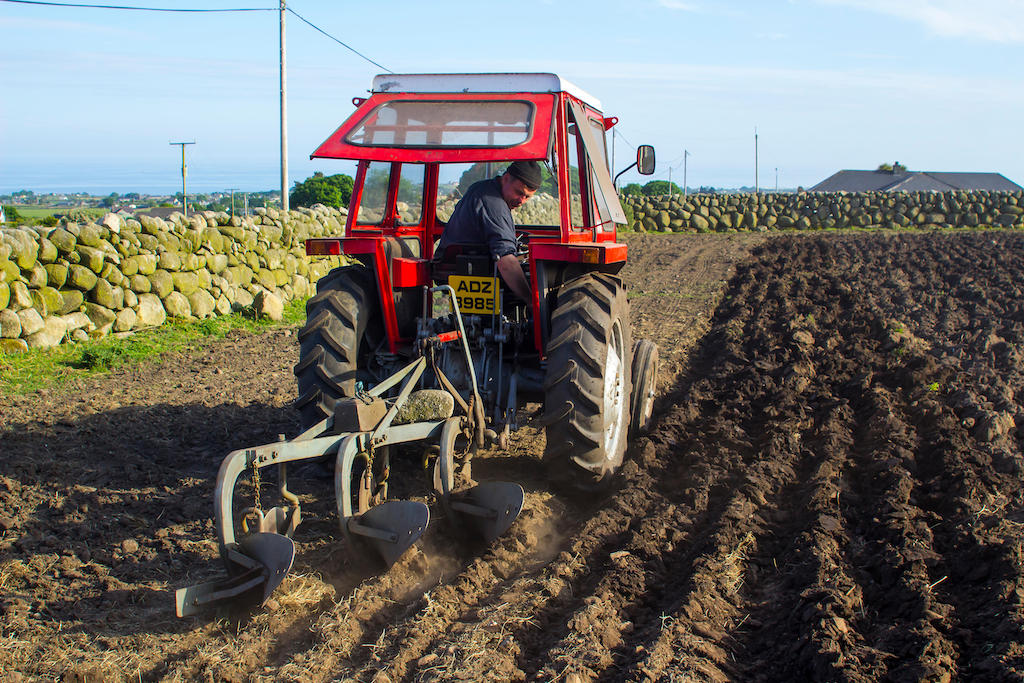
The powersharing executive in Northern Ireland has been in limbo since February 2022 when the Democratic Unionist PartyboycottedStormont to protest against the Northern Ireland Brexitprotocol.
A Northern Ireland Assembly election has beenpostponed, but is due to be held in the coming months. Dobbs says:
“The instability in the Assembly makes it much more difficult to go and develop policy. Civil servants will be faced with major challenges to try and do it.
“It’s also very difficult for Northern Ireland and for the other devolved nations because they don’t know how much money they’re going to get.”
The policy, as it is currently set out, does not seem ambitious enough to achieve climate and biodiversity targets, Dobbs says, adding:
“It’s got a lot on environment, but I don’t think being more efficient in beefproductionis actually enough. That’s being more efficient, but that doesn’t solve the problems of pollution, that doesn’t solve the problems of emissions.”
UK agriculture emissionsdecreasedby 16% between 1990 and 2020. But in Northern Ireland, agriculture emissionsroseby 6% in this time.
How will farmers be affected by Elms?
Elms has been controversial among sections of England’s farming community, who say the loss of no-strings-attached subsidies threatens their incomes and food production.
Minette Batters, president of theNational Farmers’ Union(NFU), which represents around 47,000 farming businesses in England and Wales,saidtowards the end of 2022 that she would like to see the Elms rollout delayed and subsidies retained:
“I do support maintaining direct payments in order to build a scheme that really will deliver for food production and the environment.”
As direct payments are currently being wound down, many farmers are facing a financial shortfall. By 2024, theywill seea 50-70% drop in the subsidies that make up, on average, 58% of anEnglish farm’s income.
NFU analysis from 2021 hassuggested平均medium-performing农业企业, would see a 14% reduction in profits in 2022 and a 35% reduction by 2024.
Elms payments are supposed to go some way to replacing these losses. However, farmershave been slowto take up the new schemes,blaminga delayed rollout and lack of clarity from the government, as well as the low value of payments.
“Farming is a big industry and it can’t turn around easily,” saysDanny Teasdale, who works with farmers in Cumbria on flood resilience projects with his companyUllswater Catchment Management CIC.With that in mind, the NFU haswelcomedthe clarity provided by the government’s most recent Elms announcement.
Other farmersandlandownershave expressed optimism about the shift towards payments for environmental services.Martin Lines, a cereal farmer from South Cambridgeshire and the chair of theNature Friendly Farming Network, tells Carbon Brief:
“Many farmers have recognised that by delivering on those features they have underpinned and bolstered their production – and reduced costs. Many farmers will be able to make an income stream out of those public goods, particularly now we’re seeing [more clearly] what is available.”
There is broad agreement that, whether Elms is sufficient or not as an alternative to direct payments,more moneywill be needed as farmers struggle with rising costs due to inflation.
“Somehow, we need to bring more funding in either through public or private finance,” says Lines.
Some farmers have expressed concerns that, despite references to maintaining food production, the Elms system is predominantly about meeting the UK’s climate and nature targets.
“Rightly or wrongly, keeping farmers in business is not one of its objectives,” aneditorialinFarmers Weeklystated.
This sentiment is voiced byJoe Stanley,一个农民和农场主联合会县Leicest椅子ershire, Northants and Rutland, who tells Carbon Brief:
“Elms is not there to replace the CAP, it is not there to keep farmers farming and producing food on the land…It is there to get farmers to take land out of production and to do environmental things for them.”
Pointing to the large swathes of land used to grow crops for biofuels and livestock feed, Lines argues that many farmers were already being discouraged from producing food prior to Elms.
“We just need to make sure that the market for the food gives us a fair payment,” he says.
Moreover, as England’sNational Food Strategyconcluded, “much of the land that is best suited to nature restoration and carbon removal produces little food”.
Even so, some farmers are likely to benefit more from Elms than others. Upland sheep farms, which are oftenlinked withsignificantenvironmental impacts, are frequentlycitedas being under threat, due to their high reliance on government subsidies.
Dr Alison Holt, director of the consultancyNatural Capital Solutions, who works with upland farmers in the north of England,tells Carbon Brief that many will likely end up becoming landscape managers – restoring moorlands and heath while keeping greatly reduced herds:
“Farmers in the uplands are not really going to be farmers any more, if they decide to take this up.”
Another criticism is that Elms will favour large landowners who can afford to give over space to environmental schemes. Similar criticism has been levelled at the CAP, which provided payments on the basis of the size of area being farmed.
Will new farming plans help the UK to meet its climate and biodiversity targets?
Agriculture, which accounted for 11% of the UK’s overall greenhouse gas emissions in 2020, has a key role to play in reaching climate and nature goals. It is the fifth-highest emitting sector in the UK, according togovernment statistics.
In England, the government aims to reduce agricultural emissions by up to 6m tonnes of CO2 equivalents each year under the 2033-37 carbonbudget.This will be achieved in part through Elms as well as afundto develop new technologies and practices that reduce climate impacts.
The governmentwillalso seek further ways to help support farmers’ contributions to emission reductions, through actions such as tree planting and peat restoration. Farmers and landowners will play an “essential role” in halting species decline by 2030, the government says.
Currently, 71% of the UK’s land isusedfor farming, but the sector has been a major gap in the nation’snet-zerostrategy,consistentlyhighlightedby government advisers the Climate Change Committee (CCC).
The lack of a sector-specific plan for agriculture prompted CCC chief executive Chris Stark totell Carbon Brieflast year there was a “giant [former environment secretary]George Eustice-shaped hole in the net-zero strategy”.
This is starting to change as more details emerge about the UK’s plans for farming payments. A five-yearEnvironmental Improvement Planreleased by Defra this week sets out a “blueprint” tohalt and reversenature decline in England by 2030.
This plan connects the nation’s environment and biodiversity actions with the various targets committed to on a domestic and global scale.
It sets out an aim that 65-80% of landowners in England will adopt nature-friendly farming practices through government schemes on at least 10-15% of their land by 2030.
Defra will also establish a species survival fund to create and restore habitats. Under the first round of landscape recovery projects, 400 miles of river will be restored and 3,000 hectares of new woodlands will be established along rivers in England.
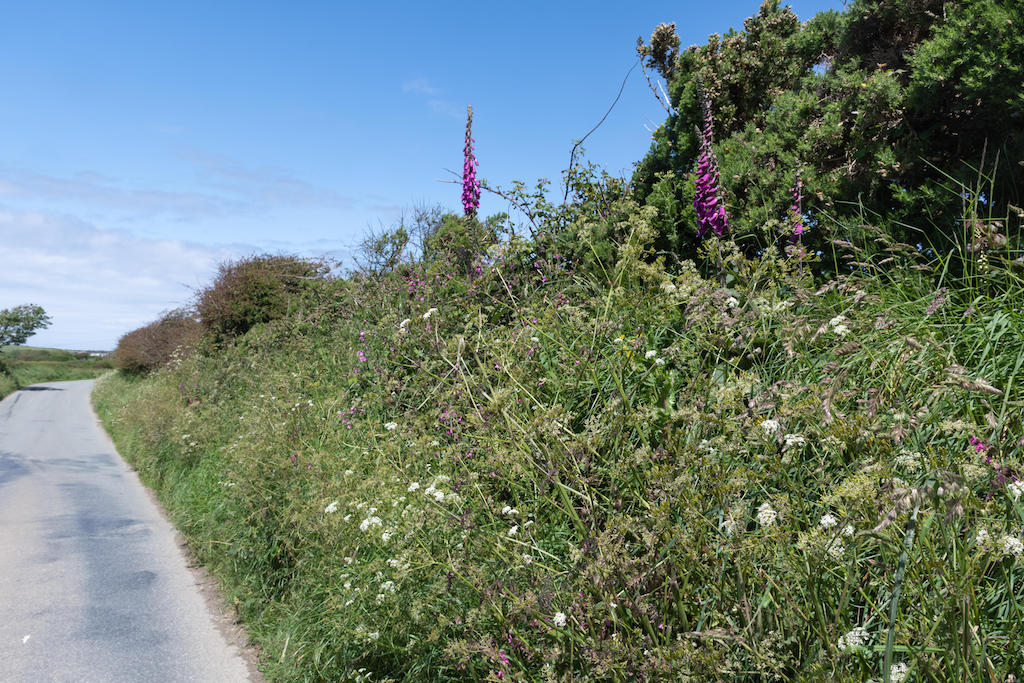
Tony Juniper, the chair ofNatural England, says the government’s targets and plans can be achieved “so long as priority is attached to it and we remain focused on joined-up delivery”.
Speaking toBBC Radio 4, he added that this will “require a step up in delivery, not only a step up in setting more ambitious targets”.
Joan Edwards, director of policy at theWildlife Trusts, told the same programme that the new plan is “a good step, but it’s just one of many documents”, adding that “our wildlife continues to decline”. She said:
“They’re setting out some targets and a plan, but where’s the funding? We need significant funding to make this happen. We need to put the plan into action. We also need all government departments to take notice of this plan.
“We need to do something really big and different over the next few years to reach30×30.”
There are overall UK targets to reach in the years ahead, but devolved nations also develop their own environmental and agricultural policies. Northern Ireland, for example, haslegislatedto reduce emissions by at least 48% by 2030.
Dr Mary Dobbs says she does not believe the post-Brexit agricultural policies in Northern Ireland go far enough to meet environmental aims. She tells Carbon Brief:
“They may help to an extent, but I do not think that they are sufficiently ambitious to address both the biodiversity and climate crises that we are facing.”
On UK policies as a whole, Dobbs adds:
“The environment is in a very bad state. There’s some good content in the various documents, including in the Elms ones that have come out, and they do incentivise. But there is a need for large-scale overhauls if we’re to actually address the problems that we’re facing.”
Food ministerMark Spencersays he wants Elms to encourage farmers to improve biodiversity. He told aparliament committeeon 15 November last year:
“I think we can produce food and we can benefit the environment at the same time. That’s what lots of farmers up and down the country have done for generations, but we can improve that and we can assist them.”
Funding farmers to manage land for nature and climate would “make most of them better off and cost the taxpayer 1.6 times less overall”, according to areportfrom environmental thinktankGreen Alliancethat models different land-use scenarios.
The report also says that reducing meat and dairy consumption would free up more land fornature-friendlyfarming andsemi-natural habitats, while also significantly reducing emissions.
The CCC hasnotedthe UK government’s lack of action on ambition or policies around reducing meat and dairyconsumption, something the NFU hasresisted, saying “choosing British-produced meat and dairy is part of the solution to the global climate challenge”.
来自英国皇家鸟类保护协会说爱丽丝新郎估ent will “really struggle” to meet its climate and biodiversity targets “based on how the schemes are currently looking” and the strategies to encourage farmers to partake in the schemes.
She says that farmers should be further encouraged and advised on the “co-benefits” of the schemes, telling Carbon Brief:
“It’s not about asking farmers to choose between birds and producing food…In light of thegovernment’s reportthat showed that the biggest risks to domestic food security were the loss of soils, climate change and loss of biodiversity, we would like the government to actually be having that conversation with farmers about the benefits of bringing nature on to the farm.”
Addressing the parliament committee in November, Spencer said that his “number one ambition” is to make the schemes easily accessible to farmers, adding:
“We will not meet any of these [Environmental Act] targets if we do not encourage farmers to get on the ladder of aspiration.”
当前的政策减排的土地re off track and peatland restoration and tree-planting rates are “falling well short of targets”, according to WWF’syabo亚博体育app下载of a freedom of information request. Government data suggests tree-planting rates have flatlined since the UK announced its target in 2019.
Easy to miss amid the flurry of depressing environmental news coming out of the UK, but the government’s tree-planting goals are slipping out of reach.
— Josh Gabbatiss (@Josh_Gabbatiss)October 10, 2022
Latest stats show rates have flatlined, despite the Conservative pledge to reach 30,000 new hectares a year by 2024.pic.twitter.com/JprVicFAkl
Dr Ludivine Petetin says it is “incredibly difficult” to know at this stage the environmental impact the schemes will have, especially outside of England where plans are still being finalised. She says:
“Those [climate] targets are binding and need to be borne in mind by governments, so of course you would expect them to fulfil their obligations. But obviously it’s too early to say one way or the other.”
In England, as highlighted above, further information has been released on Elms and how the schemes will tie into climate and nature targets.
Dr Nick Kirsop-Taylor, a lecturer in public policy and administration at theUniversity of Exeter, says the Elms information will be a “relief to farmers and conservationists alike – even if the detail represents compromises for all sides”. He adds in a press release:
“The scheme will only lead to the outcomes for nature that all parts of British society want when our environmental agencies are put on a long-term stable footing by being given the funds and people they need.
“Otherwise, we risk having world-leading agri-environmental policy that’s badly implemented. In the decade for ecosystem restoration, we need all parts of national agri-environmental policy and governance functioning properly.”





